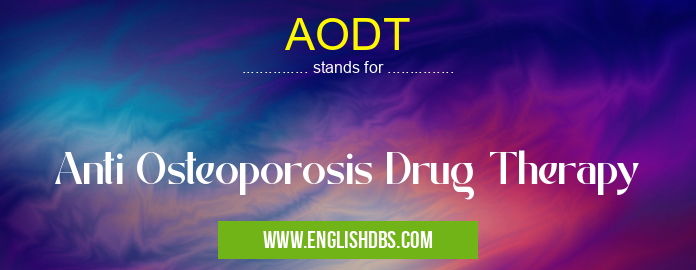What does AODT mean in THERAPY
The abbreviation AODT stands for Anti Osteoporosis Drug Therapy. This medical term describes the treatment prescribed for patients with a diagnosis of osteoporosis, or loss of bone density due to aging or other factors. Osteoporosis is a condition in which bones become fragile and brittle and can break easily as a result. The most common type of therapy used to help treat this condition is AODT, which involves taking drugs that are specifically designed to slow or stop the progress of the disease and help strengthen the bones.

AODT meaning in Therapy in Medical
AODT mostly used in an acronym Therapy in Category Medical that means Anti Osteoporosis Drug Therapy
Shorthand: AODT,
Full Form: Anti Osteoporosis Drug Therapy
For more information of "Anti Osteoporosis Drug Therapy", see the section below.
What Is Osteoporosis
Osteoporosis is a condition in which bones become weaker and more likely to fracture from even minimal pressure, such as bending over or lifting a lightweight object. It can be caused by genetic factors, medical conditions such as diabetes, hormonal changes related to menopause, certain medications such as corticosteroids, imbalances in vitamins and minerals, calcium deficiency or inadequate physical activity. Additionally, smoking and drinking alcohol can increase the risk of developing osteoporosis. When diagnosed early on, it's possible to slow down or even reverse its progression with lifestyle modifications and medication therapy such as AODT.
What Is AODT
AODT is an anti-osteoporotic drug therapy that helps patients with osteoporosis heal by slowing down the loss of bone density while strengthening existing bones. There are several types of medications used in this form of treatment, including bisphosphonates like alendronate (Fosamax) and risedronate (Actonel). These drugs work by binding to the surface of existing bone cells to prevent them from breaking down faster than normal; this provides extra support so that new bone growth can occur naturally. Additionally, some forms of hormone replacement therapy may also be prescribed in conjunction with AODT for older women who have suffered decreased estrogen levels due to menopause.
Essential Questions and Answers on Anti Osteoporosis Drug Therapy in "MEDICAL»THERAPY"
What is Osteoporosis?
Osteoporosis is a condition characterized by low bone mass and increased fragility. This leads to increased risk of fractures, particularly in the hip, spine, and wrist bones.
What is Anti Osteoporosis Drug Therapy (AODT)?
Anti Osteoporosis Drug Therapy (AODT) is a form of treatment for people diagnosed with osteoporosis. These drugs can help slow down or prevent further bone loss and reduce the risk of fractures.
Who should receive AODT?
AODT should be considered for individuals who have been diagnosed with osteoporosis or have a high risk of developing it due to certain health conditions or lifestyle factors such as advanced age, smoking, excessive alcohol consumption, low body weight, etc.
What are the side effects associated with taking AODT?
Common side effects associated with AODT may include gastrointestinal distress, muscle pains, joint pains and headaches. Long term use may also increase risk for certain medical issues such as ulcers, kidney stones and esophageal reflux disease.
Do I need regular blood tests while taking AODT?
Yes. Regular monitoring of blood levels is necessary when taking AODT in order to ensure that the drug levels remain within therapeutic range and there are no adverse effects on other organs such as kidneys or liver.
Is physical activity important when receiving AODT?
Yes. Physical activity such as weight-bearing exercises and strength training can help maintain bone mass, improve balance and coordination along with increasing overall fitness level which helps reduce the risk of falls thus reducing fracture risk associated with osteoporosis.
Are there any supplements I can add to my treatment while receiving AODT?
In addition to taking prescribed medication it is recommended that you consume adequate amounts of calcium and vitamin D through diet or supplements to help support optimal bone health during treatment with AODT.
How long does it take for me to see improvement while on AODT?
The effects of treatment set in gradually over time so improvements may not be seen right away; it usually takes several weeks for the drugs to reach their full effect. Periodic scans along with regular doctor visits can help monitor progress over time.
Are there any foods I should avoid while receiving AODT?
As each person's dietary needs vary depending on individual health conditions it's best to consult a healthcare provider before making any changes in your diet; however some general food items like caffeine beverages (like coffee), energy drinks and carbonated sodas should be avoided since they cause leaching of calcium from bones.
Final Words:
AODT is an important part of treating osteoporosis since it slows down the progression of this condition while supporting existing bone cells. Medications commonly prescribed for AODT include bisphosphonates like alendronate (Fosamax) and risedronate (Actonel), while additional therapies such as hormone replacement therapy may also be recommended depending on the individual patient’s needs and diagnosis. This form of drug therapy has been proven effective in helping people with osteoporosis manage their symptoms and improve their overall quality of life through increased strength and protection against fractures from minor falls or injuries.
